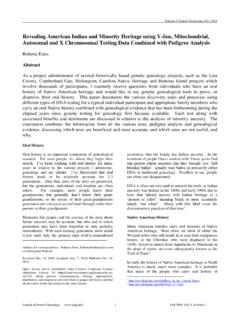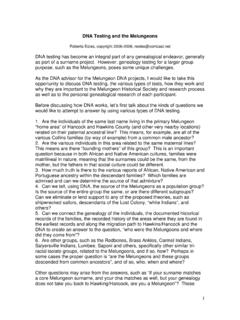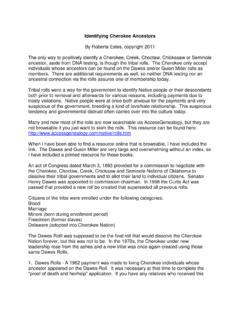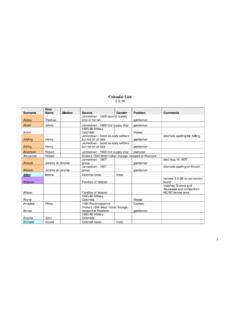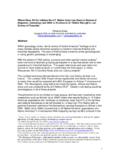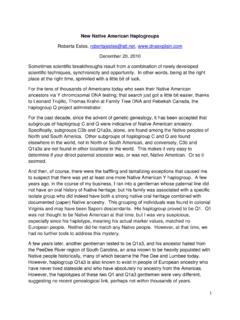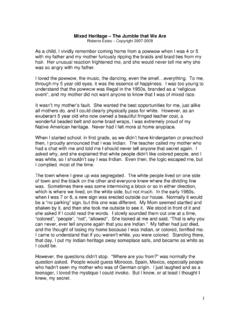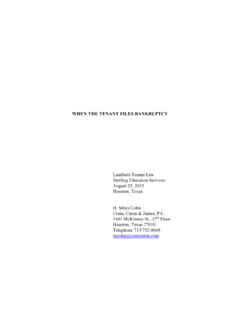Transcription of Melungeons, A Multi-Ethnic Population - DNAexplain
1 1 melungeons , A Multi-Ethnic Population Roberta J. Estes, Jack H. Goins, Penny Ferguson, Janet Lewis Crain Abstract The melungeons were a group of individuals found primarily in Hawkins and Hancock Counties of Tennessee and in the far southern portion of Lee County, Virginia which borders Hawkins and Hancock counties in Tennessee. At one time isolated geographically on and near Newman's Ridge and socially due to their dark countenance, they were known to their neighbors as melungeons , a term applied as an epithet or in a pejorative manner. As the stigma of a mixed racial heritage dimmed in the late 20th century and was replaced by a sense of pride, interest in the genealogy and history of the Melungeon people was born. With the advent of the internet and popular press, the story of these people has become larger than life, with their ancestors being attributed to a myriad of exotic sources: Sir Walter Raleigh's Lost Colony, Ottoman Turks, The Lost Tribes of Israel, Jews, Gypsies, descendants of Prince Madoc of Wales, Indians, escaped slaves, Portuguese, Sir Francis Drake's rescued Caribbean Indians and Moorish slaves, Juan Pardo's expedition, De Soto's expedition, abandoned pirates and Black Dutch, among others.
2 Melungeon families themselves claimed to be Indian, white and Portuguese. Furthermore, as having Melungeon heritage became desirable and exotic, the range of where these people were reportedly found has expanded to include nearly every state south of New England and east of the Mississippi, and in the words of Dr. Virginia DeMarce,1 Melungeon history has been erroneously expanded to provide "an exotic sweeps in virtually every olive, ruddy and brown-tinged ethnicity known or alleged to have appeared anywhere in the pre-Civil War Southeastern United States."2 This paper first defines the Melungeon Population study group, then uses Y-line, mitochondrial and autosomal DNA to evaluate their ancestry in conjunction with existing documentary records. Formation of Melungeon DNA Project The Core Melungeon DNA Project was formed at Family Tree DNA in July of 20053 with the goal of testing the Y-line and mitochondrial DNA of families identified as Melungeon.
3 The first step was to define which families were Melungeon and were eligible to be included. 1 Dr. Virginia Easley DeMarce is the past president of the National Genealogy Society, former college professor, now retired from the US Bureau of Indian Affairs. 2 DeMarce (1996) - Review Essay by Dr. Virginia Easley DeMarce of The melungeons : A Resurrection of a Proud People, An Untold Story of ethnic Cleaning in America by Brent N. Kennedy with Robyn Vaughan Kennedy, Mercer University Press, 1994, review published in the National Genealogy Society Quarterly, Vol. 84, No. 2, June 1996, p 137 republished online at 3 Project was formed at Family Tree DNA by Jack Goins, Penny Ferguson, and Janet Crain, 2 The popular press has extended the definition of Melungeon dramatically. The project administrators researched various records to determine where the label of Melungeon was actually applied, and to whom.
4 They found the word first recorded in 1810 and used for the next 100 years or so, primarily in Hawkins and Hancock Counties in Tennessee, and slightly into neighboring counties where the Melungeon family community reached over county and state boundaries into Claiborne County, Tennessee, and Lee, Scott and Russell Counties in Virginia. The project was subsequently broken into Y-line and mitochondrial DNA projects, and in 2010, a Melungeon Family project was added with the advent of the Family Finder product. First Records of Melungeon The first recorded instance of any word resembling Melungeon is found surrounding an 1810 event in Arkansas. In 1972, Baxter County, Arkansas published a Centennial edition of its history. In it they describe a Tennessean, Jacob Mooney, along with Jacob Wolf, reportedly of Hawkins County, Tn.,4 who made numerous incursions into Arkansas for the purpose of trading livestock, etc.
5 The following passage describes Mooney's first trek to Baxter County in 1810. "The four men who had come with Mooney were men of Mystery, referred to by oldtimers who knew of them as "Lungeons." They were neither Negro or Indian and in later years Jacob Mooney was ostracized for living with these "foreigners"..by the time he moved to Arkansas for good, his former slaves and the "lungeon" men had died and most of their families had moved west with the Indians."5 The next written record of melungeons is found in Russell County, Virginia in the Stony Creek6 church minutes in 18137 when a reference was made to harboring them Melungins. 8 From that point forward in time, we access historical documents to determine which families were originally considered to be Melungeon. As early as 1848, the outside world heard of the melungeons and became interested when Littell's Living Age9 published an article referring to the melungeons in which it was claimed that: 4 Carlson (2000) footnote 579 5 Messick (1972) p 6-7 6 Stony Creek Church is located in current Scott County, Virginia, about 40 miles east of Blackwater Church in Hancock County, the original church of the Melungeon Community.
6 Some individuals were members of both churches. Stony Creek and Blackwater, in 1802-1803 according to the church minutes. 7 Stony Creek Chrch Minutes (1801-1814): Transcribed in 1966 by Emory L. Hamilton, then again in 1982 by Garnell Marshall and subsequently privately published. In both transcriptions, the word is transcribed as "Melungins." 8 A list of church members before 1819 is provided by Addington (1992) and is available at +creek+church+scott+county+virginia&sour ce=bl&ots=JIGylzYnPK&sig=3pI7 LNbF1uj9I-fsfvJ3L9oNokw&hl=en&ei=XER8 SuSZIJLcNcGtuPQC&sa=X&oi=book_result&ct= result&resnum=5#v=onepage&q=&f=false 9 Author unknown (1848) 3 "A great many years ago, these mountains were settled by a society of Portuguese adventurers, men and women - who came from the long-shore parts of Virginia. These intermixed with the Indians and subsequently their descendants (after the advances of the whites into this part of the state) with the negros and the whites, thus forming the present race of Melungens.
7 " With this article, cultural interest in the group of people known as melungeons began, and various articles and publications followed, some of which contained information that related to their heritage. Year Source Melungeon References Provided 1810 History of Baxter County Arkansas10 First reference to melungeons in written records indicating they were from Hawkins County, Tn. 1813 Stony Creek Church Minutes (1801-1814), Russell Co., Va. First local reference to melungeons - reference to "harboring them Melungins." 1848 Littell's Living Age "Society of Portuguese came from the long-shore parts of with the Indians and subsequently their the negroes and the whites" 1886 Goodspeed's History of Tennessee11 Says Newman's Ridge "has since been occupied mainly by a people presenting a peculiar admixture of white and Indian blood." 1888 1889 1890 1907 1915 Hamilton McMillan12 Lumbee as descendants of Lost Colony, Lumbee "formerly called themselves Melungeans", Lumbee "branch of the Melungeans", Lumbee "call themselves Malungeans", says Melungeon designation preceded first tribal name 1889 Dr.
8 Swan Burnett13 "Proudly call themselves Portuguese." 1889 Atlanta Constitution letter from Laurence Johnson14 "Claim to be Portuguese - original site on the Pedee River in NC and consisting mostly of Moors with sprinkling of Arabs and negroes turned ashore wives among Indians, negroes and cast off white people of color of Pedee region." 1890 1890 census paperwork15 " melungeons in Hawkins County claim to be Cherokees of mixed blood (white, Indian and negro)..Collins and 10 Messick (1972) 11 Goodspeed, (1886): While not mentioning the melungeons by name, does reference the Newman's Ridge Population ; "A settlement was also made at an early date at Mulberry Gap, where a little village sprang up. Newmans' Ridge, which runs through the county to the north of Sneedville, and parallel with Clinch River, is said to have taken its name from one of the first settlers upon it.
9 It has since been occupied mainly by a people presenting a peculiar admixture of white and Indian blood." 12 McMillan (1907) p 41 13 Burnett (1889) Vol. 11, p 347-349 14 Johnson (1889): For the full text of Johnson's reply letter, see , the original article has never been located. 15 Governmental census site (2011) 4 Gibson reported as Indian, Mullins white, Denham Portuguese, Goins as of the races which they most resembled." 1890 1891 Articles by Will Allen Dromgoole,16 Nashville Reporter "Claim to be Cherokee and Portuguese", some claim a drop of African blood, Collins and Gibson claimed Cherokee ancestors, "stole names of Collins and Gibson from white settlers in Virginia where they had lived previous to North Carolina", white (Mullins), Portuguese pirate (Denham) and African (Goins). 1897 "A Visit to the melungeons " by Humble17 "We know that Mullens and Moores received their names from white husbands and fathers, and we do no violence to the probabilities by assuming that the prevalent names, Collins, Gibson, Williams, Goans, Bell came in the same way.
10 " 1903 1914 Lewis Jarvis, Hancock County Tn., attorney and historian18 "Called Melungeon by the local white here when first hunting parties land grants where they formerly the friendly Indians who came with the whites as they moved west" to the New River and Fort among the whites. Names Collins, Gibson, Bolin, Bunch, Goodman, Moore, Williams, Sullivan and "others not remembered" as Indian. 1907 Hodges Book of American Indians north of Mexico by James Mooney19 "A mixture of white, Indian and Redbones of SC and the Croatans [now Lumbee] of North Carolina seem to be the same mixture" and "Croatoan, Redbones, Delaware Moors and melungeons are of similar origin" and "name Melungeon is probably from melange-mixed or Portuguese." Table 1: Melungeon Heritage Table In 1903, Lewis Jarvis,20 a local attorney who lived and worked with the Melungeon families and was ultimately responsible for identifying many of the families by name, wrote the following: 21 "Much has been said and written about the inhabitants of Newmans Ridge and Blackwater in Hancock County, Tennessee.
